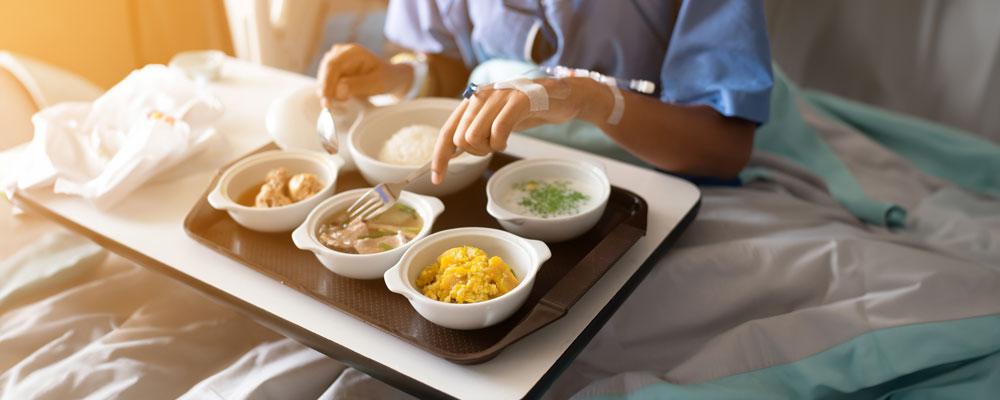With meals in hospitals forming a key part of an individual’s hospital stay, the NHS is on the road to making sure it is both nutritious and playing a part in their journey to net-zero.
When you’re cooped up in hospital away from much-needed home comforts, one of the main aspects patients miss is good quality food.
In August, a survey from the charity Eating Better found that 78 per cent of respondents want healthier food in hospitals, and that public sector procurement can help achieve ‘better’ meat and dairy being served.
The survey revealed that 65 per cent agreed that ingredients known to cause health problems, such as processed meat, should not be served in schools and hospitals.
Additionally, 84 per cent think that sourcing UK-grown food for schools and hospitals is a good way to support our farmers.
The NHS has introduced plenty of guidelines for hospitals and healthcare settings to implement tasty and nutritious food for patients.
In 2020, the NHS became the world’s first national health system to commit to becoming net zero carbon, this was in response to the threat to health posed by climate change.
It is estimated that food and catering services in the NHS produce 1,543 ktCO2e each year, equating to approximately six per cent of total emissions. This places a huge responsibility on the hospital caterer to look at ways of reducing that footprint.
There have been efforts to bring hospital catering back in-house to make sustainable and financial gains. This includes reducing transport costs, lessening the carbon footprint and environmental impact, as well as improving quality and minimising costly waste.
At Imperial College Healthcare NHS Trust for example, they have introduced more sustainable catering at their hospital sites through a food and retail transformation programme which maps sustainability from farm-to-plate.
Like most initiatives, there is a catchy alliterative list of words to summarise the best ways to create sustainable and healthy food in healthcare.
Reduce
Covered under this first topic is maximising resource efficiency and reducing consumption. There are several aspects that need to be considered for this, such as economic and environmental.
Food miles are a big factor to consider. The term refers to the distance food is transported from the time it is made to the time it reaches the consumer. Typically the further food travels, the worse its carbon footprint.
To avoid transporting food huge distances to different hospitals, trusts sometimes have the option to find local suppliers.
Reuse
Switching to reusable cutlery rather than single use is a great way to reduce the carbon footprint of catering in healthcare.
A lot of industries have been taking these steps, and the NHS can certainly learn from the wider catering industry.
The NHS is the largest user of single-use plastics in Europe, with services across the NHS in England using more than 600 million disposable cups and millions of disposable cutlery pieces as well as other avoidable single-use clinical and non-clinical plastic items between 2013-2018.
In 2020, almost one quarter of the NHS’s waste in England and Wales was plastic. In April 2021, the NHS could no longer purchase single-use plastic cutlery, plates or single-use cups made of expanded polystyrene or oxo-degradable plastics.
Continuing to push for banning single use plastics in hospitals is a great step to make catering in hospitals more sustainable.
Remanufacture
Waste generation is closely tied to consumption and production patterns. Shifting from a linear model of production, consumption, and disposal to sustainable practices supports remanufacture and recycling.
Disposing of products at their end of life isn’t just an environmental issue; it’s also economic. Waste contributes to the NHS carbon footprint and poor waste management affects climate change and air quality. In a circular economy, waste becomes a resource.
Recovered and recycled materials re-enter the supply chain, reducing the need for new resource extraction.
Adopting circular economy principles in our frameworks supports the journey to net zero. Infrastructure, partner collaboration, behaviour change, and recognising waste as a resource are essential.
Introducing more plant-based meals
Moving on from the trusty alliterative list, introducing plant-based meals is another way to reduce the NHS’ carbon footprint and make tasty food.
The Vegetarian Society estimates that 4.5 per cent of the UK population have a vegan or vegetarian diet.
This means that many people in hospitals are looking for plant-based meals during their stay. According to Plant Based Healthcare Professionals UK, an additional source of stress for vegans and those following a plant-based diet can be accessing appropriate meals.
Not eating animal products means healthcare settings can decrease their carbon footprint, minimise land use, and mitigate environmental degradation associated with livestock farming.
Under the Equality Rights Act 2010, hospitals have to provide vegan meal options as it would otherwise be considered discrimination.
However, the quality of these meals has often been put under scrutiny.
The Vegan Society said on their website: “It’s important for public institutions like hospitals to cater for vegan patients, but vegan food can be enjoyed by most people so let’s get more of it on hospital menus. Great vegan food can promote inclusivity, sustainability and good nutrition.”





